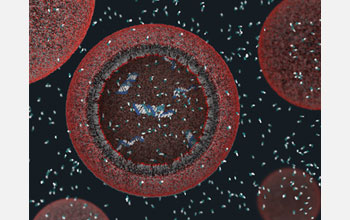All Images
News Release 08-094
A New Way to Think About Earth's First Cells
Study provides insight into how Earth's earliest cells may have interacted with their environment
This material is available primarily for archival purposes. Telephone numbers or other contact information may be out of date; please see current contact information at media contacts.

Above is a three-dimensional view of a model protocell approximately 100 nanometers in diameter. The protocell's fatty acid membrane allows nutrients and DNA building blocks to enter the cell and participate in non-enzymatic copying of the cell's DNA. The newly formed strands of DNA remain in the protocell.
Credit: Janet Iwasa, Szostak Laboratory, Harvard Medical School and Massachusetts General Hospital
Download the high-resolution JPG version of the image. (7 MB)
Use your mouse to right-click (Mac users may need to Ctrl-click) the link above and choose the option that will save the file or target to your computer.
Fatty acids may have formed near hydrothermal vents. This animation shows a theoretical scenario in which fatty acids are formed on the surface of minerals deep underground and then brought to the surface by the eruption of a geyser.
Credit: Janet Iwasa, Szostak Laboratory, Harvard Medical School and Massachusetts General Hospital
The process by which fatty acid micelles may form a vesicle is shown in this animation.
Credit: Janet Iwasa, Szostak Laboratory, Harvard Medical School and Massachusetts General Hospital


